| ENTER THE ELECTRONIC RIVER | ||||
| The theme for "Enter the Electronic River" developed as I searched for a symbol that would represent our part of the world, as well as serve as a metaphor for the gathering of images flowing through the virtual space of telematics. | ||||
| The "mailing" for this installation went out to over 350 fax artists from 31 countries who are listed in F'AXis '94, a fax artists' directory I compiled with colleagues in Brazil, France, Germany, Spain, United Kingdom and the USA. The information was sent to them via fax, electronic mail and traditional mail. I have been participating in and coordinating worldwide fax art events since 1990, but this is the first event where I have been physically present! | ||||
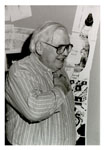 |
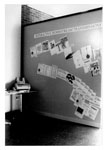 |
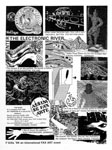 |
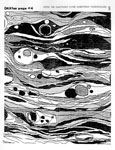 |
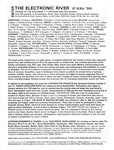 |
| The images and texts for the exhibit came from 108 artists from 19 countries from Asia, Australia, Europe, Central, North & South America, in response to our theme, and range from a one page size to a forty page mural. Gender participation is 70% male and 30% female. The pieces fall primarily into five groups: (1) horizontal & vertical aquatic flows, textures, maps & landscapes, from chaotic to orderly (2) circular forms & droplets / ripple effects / waves with reference to Taoist philosophy (3) images of people suggesting flows of consciousness and life blood from birth to death and state of being (4) human constructions that span these flows, including bridges, building facades and other structures, and finally (5) conceptual statements, poems and haiku. This art is a reflection of contemporary society, as well as a presentation of a collective imagination. | ||||
In addition to the installation we have undertaken several interactive projects that will develop between October 3 and 15. The first is entitied THE RIVER OF TIME and was initiated by Regina Vater of Austin, Texas, USA, and involves faxing a message around the globe from time zone to time zone to our 12 participants on five continents. The second project THE RIVER OF ENDLESS RETURNS was initiated by us and involves the creation of composite fax images culled from the exhibit and transmitting them to designated "Electronic River Guides" in the USA, Brazil, Costa Rica, Germany, UK, Spain & Australia. The third project was initiated by Bruce Breland, Digital Art Exchange West in Spokane, Washington, USA and is called CREATE YOUR OWN RIVER! This project is also open to the gallery audience and the Linfield community, and participants are asked to prepare a section of the 100 page paper river by xeroxing the close-up riverine view provided and by shaping and manipulating the image. The fourth project, HAPPY RIVER, was initiated by 14 Brazilian artists to send friendly energy flowing south to north through Brazil, arriving in Oregon an October 2. It will travel east-west before returning to Brazil! |
||||
| BACKGROUND | ||||
| Since the beginning of the 1980's, artists worldwide have explored the use of telecommunications as new media for interactive artworks using images and texts. Using a variety of themes, these artists have focused, not on individual works as is traditional in the fine arts arena, but on works that have multiple authors and undergo many transformations as the fusion of visual dialog proceeds. The facsimile (FAX) machine is one of the most user friendly methods of artistic exchange in the electronic arts field because of its ease of use and access. In the digital revolution and fax constructed cosmos, national and international boundaries are dissolved and geographical location and size of community are all irrelevant. Images can overcome language barriers and senders / receivers become equal partners in an inclusive global and cultural interchange of chance encounters. It is essential that arts and humanities groups participate in the technological culture in order to make sure that they have an impact on the cultural and aesthetic shaping of the medium. |
||||
| Since 1980 over 100 fax art projects have taken place in a variety of venues in Africa, Asia, Australia, Central & South America, Europe, and North America. Many of the participating artists also interact through electronic mail, slow scan TV and video. At present the electronic art world has a strong European/North American axis, due in part to equipment access, finances and the use of English as an international language. Artists seeking worldwide dialog hope this bias will change so they can produce interactive works within a broader cultural framework. | ||||
| REFERENCES | ||||
| to be published in 1994: | ||||
| 1. "Fax art - artistic praxis" International Museum of Electrographic Art, University of Castilla-La Mancha, Cuenca, Spain | ||||
| 2. "The creative language of the facsimile" by Edward Booth-Clibborn, London, UK | ||||
| 3. "Fax Issue" by the Editors of Arneykkotok Electrographic Art International Journal, Budapest, Hungary | ||||
| Published: | ||||
| 1. "The telephone book" by Avital Ronell, University of Nebraska Press, Lincoln, Nebraska, 1989 | ||||
| 2. "Navigating in the telematic sea" guest editor Bruce Breland, director, DAX group, includes "Global frontiers for art" by Lowry Burgess, p. 23, & "Notes on fax art" by Karen O'Rourke, pp. 24-25, New Observations Issue #76, New York, NY, May 15-June 30, 1990 |
||||
| 3. "Connectivity: art and interactive telecommunications" editorial by Roy Ascott. Leonardo Vol. 24 #2, pp.115-117, Pergamon Press, Elmsford, NY, 1991 | ||||
4. "Technology, artistic production & the aesthetics of communication" by Mario Costa, Leonardo Vol. 24 #2, pp. 123-125, Pergamon Pr., Elmsford, NY, 1991 |
||||
5."Around the world in 80 nanoseconds" by Patricia O'Toole, Lears Magazine, pp. 24-25, January, 1991, review of "Powershift" by Alvin Toffler. |
||||
| 6. "Aspects of the aesthetics of telecommunications" by Eduardo Kac, ACM Siggraph 92, Visual Proceedings, July 26-31, Chicago, Illinois, 1991 | ||||
| 7. "Post modern currents: art & artists in the age of electronic media" by Margaret Lovejoy, Prentice Hall, Englewood Cliffs, NJ, 1992 | ||||
| 8. "The art of the electronic age" by Frank Popper, Abrams, New York, NY, 1993 | ||||
| 9. "High technology meets art - digitizing the museum" special issue, Reflex, August / September, Vol. 8 #4, Seattle, Washington, 1994 | ||||
10."Fax-da descoberta cientifica ao fazer artistico" by Paulo Bruscky, Companhia Editora de Pernambuco, Supplemento Cultural, August 1994, pp. 3-6, Recife, Pernambuco, Brazil |
||||
| Information prepared by Lilian A. Bell, artist coordinator for ENTER THE ELECTRONIC RIVER | ||||
| ^ top ^ | ||||